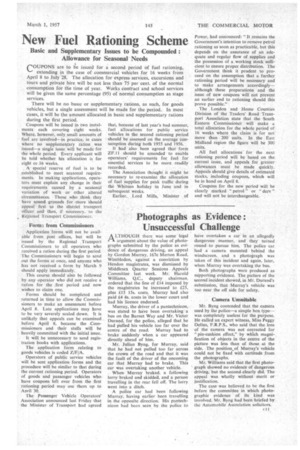Photographs as Evidence : Unsuccessful Challenge
Page 53

If you've noticed an error in this article please click here to report it so we can fix it.
Application forms will not be available from post offices, but will be issued by the Regional Transport Commissioners to all operators who received a ration during the first period. The Commissioners will begin to send out the forms at once, and anyone who has not received a form by March 9 should apply immediately.
This course should also be followed by any operator who did not receive a ration for the first period and now wishes to claim one.
Forms should be completed and returned in time to allow the Commissioners to make an assessment before April S. Late applications may have to be very severely scaled down. It is unlikely that appeals can he examined before April 8, because the -Commissioners and their staffs will be heavily committed with the initial issue, It will be unnecessary to send registration books with applications.
The application form relating to goods vehicles is coded Z/F/A.
Operators of public service vehicles will be sent application forms and the procedure will be similar to that during the current rationing period. Operators of goods and passenger vehicles who have coupons left over from the first rationing period may use them up to April 30.
The Passenger Vehicle Operators' Association announced last Friday that the Minister of Transport had agreed ALTHOUGH there was some legal argument about the value of photographs submitted by the police as evidence of dangerous driving, an appeal by Gordon Murray, 167c Merton Road, Wimbledon, against a conviction by Hendon magistrates, was dismissed by Middlesex Quarter Sessions Appeals Committee last week. Mr. Harold Williams, Q.C., deputy chairman, ordered that the fine of £14 imposed by the magistrates be increased to £25, plus £15 15s. costs. Murray had also paid £4 4s. costs in'the lower court and had his licence endorsed.
Murray, the driver of a pantechnicon, was stated to have been overtaking a bus on the Barnet Way and Mr. Victor Durand, for the police, alleged that he had pulled his, vehicle too far over the centre of the road. Murray had to brake suddenly when a car appeared directly ahead of him.
Mr. Julian Byng, for Murray, said that he had not pulled too far across the crown of the road and that it was the fault of the driver of the oncoming car that Murray had to brake. This car was overtaking another vehicle.
When Murray braked. a following lorry braked and skidded, and a person travelling in the rear fell off. The lorry went into a ditch.
A police car had been following Murray, having earlier been travelling in the opoosite direction. His pantechnicon had been seen by the police to have overtaken a car in an allegedly dangerous manner, and they turned round to pursue him. The police car had a camera mounted behind the windscreen, arid a photograph was taken of this incident and again, later, when Murray was overtaking the bus.
Both photographs were produced as supporting evidence. The picture of the second incident showed, in Mr. Durand's submission, that Murray's vehicle was too near the off side for safety.
Camera Unsuitable
Mr. Byng contended that the camera used by the police—a simple box type— was completely useless for the purpose. He called an expert witness, Miss Peggy Delius, F.R.P.S., who said that the lens of the camera was not corrected for pin-cushion effect," by which magnification of objects in the centre of the picture was less than of those at the side. The position_of Murray's vehicle could not be fixed with certitude from the photographs.
Mr. Williams said that the first photograph showed no evidence of dangerous driving, but the second clearly did. The appeal was wholly without merit or justification.
The case was believed to he the first before the committee in which photographic evidence of its kind was involved, Mr. Byng had been briefed by the Automobile Association solicitors.












































































































